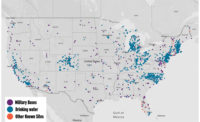The Environmental Working Group is proposing a stringent drinking water and cleanup standard of 1 part per trillion for a group of toxins known as PFAS after a study found triple the amount of contamination that was known a year ago. The recommendation is in stark contrast to the Environmental Protection Agency’s April 25 interim recommended clean up standard of 70 ppt for two chemicals in the group – PFOS and PFOA.
The environmental advocates also recommended the PFAS chemical group, which contain many synthetic fluorinated organic chemicals, be regulated as a single class, not as individual chemicals. EPA estimates more than 5,000 chemicals are in the group. They were used in hundreds of consumer products including cookware, food packaging and stain repellants and have been linked to various health issues and cancers.
The amount of contamination is much greater than previously thought, EWG said May 6. As of March 2019, at least 610 locations in 43 states were know to be contaminated with PFAS chemicals, including drinking water systems serving an estimated 19 million people. The number of known contaminated sites was 172 in July 2018.
The Social Science Environmental Health Research Institute at Northeastern University in Boston updated the list of sites from new data sources, EWG said.
EWG is not saying every site on the map has water that’s unsafe to drink, but it does endorse research showing that PFOA (perfluorooctanoic acid) and PFOS (perfluorooctanesulfonic acid) can harm human health at levels as low as 1 ppt, says Bill Walker, EWG’s vice president.
EPA’s recommendation was based on its current scientific understanding of PFAS toxicity, including the agency’s PFOA and PFOS health advisories, says Administrator Andrew Wheeler. The recommendations may be revised as new information becomes available.
“Today, we are delivering on one of our most important commitments under the PFAS Action Plan,” Wheeler said when the new standard was announced in April.
An April 1 proposal by the New Jersey Department of Environmental Protection set the maximum allowable limit for PFOA at 14 ppt and the PFOS limit at 13 ppt. A public comment period on the proposal closes at the end of May.



Post a comment to this article
Report Abusive Comment